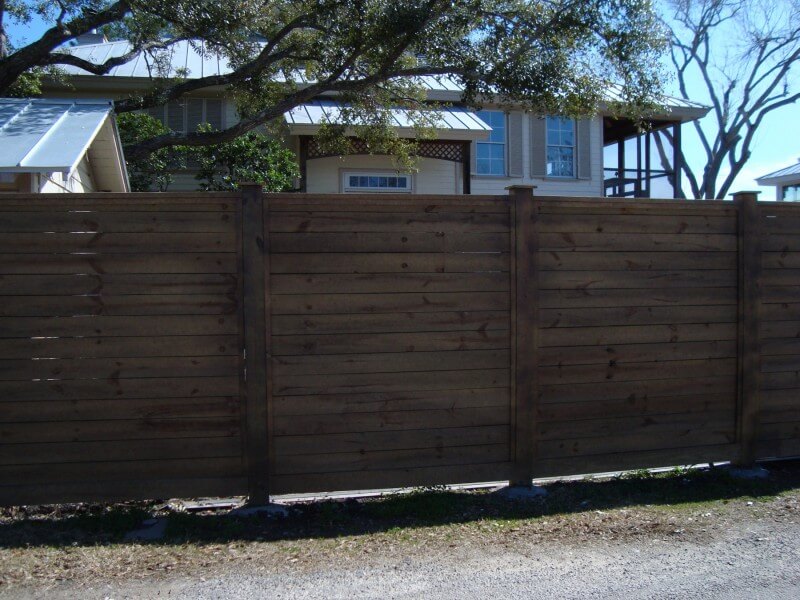Horizontal Wood Fence Ideas
Horizontal Wood Fence Ideas to Transform Your Yard

Gone are the days of the mundane, boring, old-fashioned fence and yard design! Now is the time to get creative and add some pizzazz to your home with a horizontal wood fence that will transform your yard into a stunning creative modern masterpiece. From subtle and classic to bold and eye-catching, the possibilities are endless when it comes to incorporating a horizontal wood fence into your yard design. Our list of 10 creative horizontal wood fence ideas will help get the creative juices flowing when it comes to your own creative yard masterpiece. So, let’s get started!
Horizontal wood fencing is a great choice for adding visual interest to your outdoor space. Consider using contrasting colors of wood or adding an additional layer of boards for extra texture and color variation.
Types of Horizontal Fences
When it comes to finding the right type of fence for your yard, one of the crucial decisions is deciding on what type of material you should use. Horizontal fences are a great way to transform your yard, but there are several different kinds you can choose from. Traditional wood fences are a popular choice due to their versatility and natural beauty. However, more and more homeowners are turning towards vinyl, metal, or composite varieties due to their durability and low maintenance requirements.
Wood offers a classic, timeless aesthetic that fits a variety of styles, from cottage to cottage-style gardens to formal landscaping with boxwood topiaries. Cedar is probably the most common type of wood used in horizontal fencing, as it’s naturally weather resistant and doesn’t need to be treated to preserve its color and prevent rot. Its long-lasting nature also makes it an affordable option in the long run. On the other hand, vinyl fencing has no recurring maintenance costs and will remain looking new for many years with just occasional cleaning needed. It provides flexibility when considering design options as well as being available in different colors and varying levels of transparency allowing for privacy without blocking out all light.
Metal and composite fences provide a strong durable solution with minimal maintenance. The sleek modern style embraces clean pristine lines providing a contemporary look that is becoming more sought after by homeowners. Although these materials can cost slightly more upfront, the low maintenance factor combined with longevity make them still very cost-effective choices for certain applications.
Transforming your yard with a horizontal fence is all about finding the right material that works best with your budget and desired aesthetic. No matter which one you choose, they all offer great benefits while adding value to your property and home. As you start researching ideas, don’t forget to consider natural wood fence options available before deciding – there may be something out there that fits perfectly into your yard’s environment!
Natural Wood Fence Ideas
Natural wood fence ideas provide a unique way to add an interesting and creative element to any yard. Natural wood such as cedar, pine, redwood, and larch are all popular materials for fencing. They can provide a traditional or rustic look that many find appealing. Depending on the specific type of wood and stain used, natural wood fences can even have a modern aesthetic as well. Furthermore, natural woods are durable and low maintenance since they don’t require painting or staining; they just need occasional cleaning with a power washer to keep them looking fresh.
On the other hand, some argue that natural wood fence ideas may not stand up as long against varying weather conditions over time or may prove to be vulnerable to some types of pests. However, given that natural woods are usually treated with a stain or sealant when installed, they should remain strong and resilient if properly maintained by an experienced installer.
Overall, natural wood fence ideas can create beautiful boundaries in any yard while adding visual appeal and character through various shades and grains of wood. They are also cost-effective and require minimal upkeep for lasting beauty. With these benefits in mind, homeowners looking for horizontal wood fence ideas should consider the timeless appeal of a natural wood fence. These factors will help lead into the next section – contemporary wood fence ideas – which explores ways to incorporate modern designs into classic wooden materials.
Contemporary Wood Fence Ideas
Contemporary wood fence ideas are gaining popularity among homeowners for their modern look and functional benefits. Natural wood is a classic choice when it comes to fencing, but contemporary designs bring a new level of beauty and sophistication to your yard. With sleek lines and innovative use of materials, these fences stand out while providing an effective barrier. Additionally, they can provide the flexibility and customization needed to suit the unique needs of your property.
Those looking for an eye-catching structure will likely appreciate the aesthetic appeal of contemporary wood fences. Highly customized designs can give your yard a unique, one-of-a-kind look. For example, alternating colors or staining boards in several different hues can create an elegant visual pattern. Additionally, using slats at varying heights can create a staggered design that draws the eye up or across the fence line. Ultimately, modern designs are sure to bring style and character to your outdoor space like nothing else can.
On the other hand, some may prefer the timeless nature of traditional wood fences which often require less upkeep than their more modern counterparts. They offer a sense of nostalgia and still feature homespun charm without sacrificing security or privacy.
In any case, there’s no wrong choice when it comes to choosing a fence for your property — just make sure the style you choose matches with your house’s overall exterior design scheme so you can be proud of its presence year after year. No matter if you opt for a modern or traditional style, wooden fencing is sure to give you peace of mind knowing your home is secure as well as add value to your space.
No matter what style you go with, whether it be natural or contemporary, wooden fences are sure to enhance the look and feel of any yard – from adding extra security and curb appeal to bringing rustic charm and warmth through their natural aesthetics. Now it’s time to turn our focus towards the traditional side of things with ideas for creating classic wooden boundaries around any home.
Wood fence ideas are gaining popularity with homeowners due to their modern and functional look. Contemporary designs offer visual appeal and flexibility to suit any property, while traditional options are still favored for their timeless charm and low-maintenance needs. No matter what style is chosen, wooden fences can provide peace of mind, extra security, and curb appeal – ultimately adding value to a home.
Traditional Wood Fence Ideas
The classic wooden fence is the quintessential choice for those looking to showcase their yard and create an inviting entrance, while also providing a secure boundary. Traditional wood fence ideas range from solid board paneled fences to picket-style fences that have been used as markers of Americana since colonial times. Depending on your preference and skill level, you can customize each option to craft a truly unique look. With durability being top-of-mind, many classic wooden fence ideas feature metal posts set within a concreted footing for stability.
A key benefit of traditional wood fence ideas is that they provide a clean, streamlined look that many homeowners desire. The boards help create a sense of enclosure and privacy, while the metal posts help ensure longevity over the years. It’s important to note that upkeep is an important part of keeping these types of fencing options looking good year-round; a coat of weatherproof finish or regular sanding-and-staining should be carried out depending on the type of fence material used. Additionally, if properly maintained and treated, classic wooden fences can be highly affordable in comparison to other fencing materials such as vinyl or aluminum.
All in all, traditional wood fence ideas are an excellent way to add charm and character to your backyard – while also serving its functional purpose. Furthermore, with options available at various price points, there’s something for anyone looking to upgrade their outdoor space. As such, it’s no surprise that these types of decorative solutions remain one the most popular choices amongst homeowners today.
Moving forward we’ll explore how you can use these design principles when selecting easy-to-build horizontal wood fence alternatives for your backyard – giving your outdoor paint canvas new depth and definition without adding complexity or cost.
Simple Construction of Horizontal Wood Fence Ideas

As an alternative to traditional wood fencing, many homeowners are now looking to horizontal fence designs for the unique aesthetic and creative design possibilities they provide. Constructing this type of fence is typically easier and more cost-effective than most people would expect, meaning it can be completed in a matter of days with the right amount of planning and preparation.
When constructing a wooden fence, one of the keys to success is using quality materials. By using treated lumber or cedar posts, your fence will be able to withstand harsh weather conditions and last longer than it would if you used softwoods like pine or spruce. Additionally, these materials won’t require as much maintenance, making them a great choice for those who want low-maintenance options. Furthermore, horizontal fences don’t need to be built as tall as a traditional picket fence, since they are designed to provide security rather than privacy. This allows homeowners to use shorter boards which may be easier and cheaper to acquire, while still achieving the same look they desire and being within any local building codes.
However, some argue that traditional wood fencing offers a sense of privacy that’s hard to replicate with horizontal fencing designs due its taller stature and fact that visitors can’t see through it. Also, aside from maintenance needing to be done for traditional fencing with regards to staining or repainting every few years, there’s also the added cost and time involved in actually constructing the fence provided one doesn’t have the ability or tools necessary to complete it on their own.
Ultimately it comes down to preference and what you hope to achieve with your outdoor space – whether you’re looking strictly for aesthetics or something which provides some sort of semblance of privacy as well. When deciding how you’d like your yard landscaped, take into account both pros and cons regarding both types of fencing in order make an informed decision about what works best for your home and budget.
Placement and Arrangement of Horizontal Wood Fence Ideas
The placement and arrangement of horizontal wood fence ideas can be just as important as the construction or chosen style of a fence. The location of a fence can play an important role in maximizing the potential aesthetic, privacy, and practical advantages it provides. As well as this, choosing to arrange supporting posts in different ways such as a “zigzag” formation, or large overlapping panels can create dramatic visual appeal.
When selecting the placement of a fence, consideration should be taken for the site orientation, gate and access points and other nearby plants, buildings, and trees. Additionally, it is wise to plan and leave room for any plants chosen to accompany the fence design further down the line. For example, if privacy is desired then space should be allocated at the bottom of the fence for climbing climbers or evergreen shrubs.
The flexibility of a horizontal wood fence allows multiple patterns of arrangement that can be used to create various effects. An eye-catching “zigzag” panel pattern can add movement to an otherwise static yard while an alternating panel pattern adds visual intrigue without compromising structure integrity. Parallel boards arranged in alternating heights or depths can also create a rhythmic and elegant effect although there must be adequate support included in this design to ensure safety and stability.
Finally, varying widths, lengths or heights within each panel can also provide interesting looks and subtle changes in aesthetics within each fence area. Ultimately though all potential conditions should be considered when designing horizontal wood fences so they can create balance with permanent elements while adding beauty to yards.
With careful consideration during placement and arrangement, horizontal wood fences have infinite possibilities regarding customization that can bring out unique characters and vibes within yards – regardless of size. Careful thought regarding plant selection surrounding these fences can also create additional layers of privacy and coziness helping transform any backyard into an inviting paradise for family and friends alike.
Outdoor Addition and Privacy Planting
When introducing a horizontal wood fence to your backyard, there are many opportunities to use outdoor additions and privacy planting to spruce up the space. The placement and arrangement of your horizontal wood fence components should be considered in combination with these exterior additions for optimal visual appeal.
Choosing the perfect plants for your yard can provide an aesthetic vision while creating extra privacy from those nosy neighbors! Consider adding complementary shrubs or hedges that can act as a “living wall” to block views from outside your property lines. Be sure to pick varieties that require minimal maintenance so that you don’t add too much burden of upkeep to your already busy schedule.
On the other hand, if you prefer more privacy than visual appeal then consider trees as a great addition to your wood fence line. They can easily block people’s sightlines while providing much needed shade in the summertime. If you want something less obtrusive, try low-growing groundcovers or ornamental grasses in your design plan. The beauty of this landscape look is that it keeps lush and green but requires little responsibility on tending it.
As you design and implement these additional elements around your horizontal wood fence project, keep in mind how each component works with and without the others. Each part of the overall composition should bring out the best characteristics in all of them – whether they are being used for privacy or aesthetic purposes. With thoughtful consideration, and the proper building materials, you can create an outdoor heaven personalized just for you!
When designing any backyard space, it is important to consider more than just one singular element — think about combining aspects together to create a beautiful and functional landscape scene.
Building on Existing Walls for Natural Look
When it comes to giving your yard a more natural look, many homeowners like to build on existing walls. Doing so offers the unique advantage of being able to blend the fence into the landscape without it sticking out too much. Plus, if the wall is made from stone, brick, or other durable materials, you can be sure that your fence will stand the test of time.
If you decide to go this route it is essential that you plan and measure carefully before beginning construction. Building off an existing wall adds complexity to installation and may require additional support depending on the size and type of materials used. It is also worth noting that if local or state regulations limit fencing height, there could be an issue with building off of an existing wall as it could cause your fence to exceed the maximum allowed height.
It can be argued that building off of existing walls not only creates a more natural look but ensures better structural integrity for your fence. The reinforcement provided by the wall logically brings strength and stability to certain designs for a stronger result. If a person is looking for a method of privacy in their yard, horizontal fences which are built directly on top of an existing wall may offer better protection from nosy passersby. On the other hand, there are those who may prefer to use traditional methods of fence installation or simply install plantings that offer privacy alongside accentuating the aesthetic beauty of their yard.
Ultimately, building on an existing wall can dramatically improve the look and feel of your yard when executed properly. Though there are pros and cons associated with this method of installation, doing so can be managed when proper research and planning are involved. No matter what route you decide to take for your yard’s fence design, adding decorative plants and landscaping elements can help create timeless style with ease going forward.
Decoration and Planting for a Stylish Touch
One of the most important parts of creating a unique and beautiful fence is taking into account decorative elements and plants. There are many options for adding a stylish touch to your fence, ranging from hanging planters or curtains to adding vines and other foliage. A few popular decoration ideas include using painting, wallpapers or mosaics for an artistic look as well as utilizing materials like lighting, metal accents, or wrought iron pieces. Incorporating plants also adds an appealing touch; creepers, climbers, bonsai trees and succulents create a natural look that can transform any yard. However, when incorporating plants into your design you should be mindful of their health requirements such as sun exposure and water needs to ensure they remain healthy in the long term.
Incorporating both decorative elements and plant life can create a stunning transformation in your yard while simultaneously allowing you to express your sense of style. All in all, thoughtfully selecting the right decorations and plant varieties paired with picking the perfect materials will give you a truly original horizontal wood fence to be proud of.
Choosing the Right Materials For Your Horizontal Wood Fence
Before you can decide on a style of horizontal wood fence, you need to consider the materials. While there is a wide variety of looks available, they all rely on similar base materials. Most commonly, cedar and spruce planks are used to build horizontal fences as these woods are readily available and are durable when treated properly. It is essential to look for wood that has been sustainably sourced and treated with water repellent sealer or stain if you’re aiming to have a long-lasting fence.
When it comes to choosing between cedar and spruce, each has its pros and cons. Unfortunately, both types of wood are vulnerable to decay, so regular maintenance is necessary regardless of the material. Cedar is more expensive than spruce but requires less upkeep as it is naturally resistant to rot and insects. It also holds color better than spruce, so if you want your new fence to remain vibrant for years to come, cedar may be your best bet. On the other hand, spruce is lower in cost, but its lighter hue does require more frequent staining. In addition, spruce planks can be narrower than those made from cedar which gives them greater flexibility in terms of design freedom.
Ultimately, a key consideration when selecting the most suitable materials for a horizontal wood fence should be regional climate and building regulations as they largely determine which type of wood will perform best over time in your region. Furthermore, local ordinances may restrict what types of wood are acceptable for use in fence building due to potential fire hazards or other safety concerns. Therefore, before making any purchase decisions, it’s essential that you consult your city or county planning department before proceeding with the project.
Common Questions
What are the common designs for horizontal wood fences?
The most common designs for horizontal wood fences are ones that have a slatted or picket design. Slatted fences typically feature wooden boards spaced evenly apart, depending on the desired level of privacy. This style of fence also looks great when painted in bright colors or stained to bring out the natural beauty of the wood. Picket fences are usually seen with square-shaped post tops and spaced pickets along the top and bottom of the fence, creating an even border throughout the yard. A more modern take on a picket fence could be having alternating heights of pickets and panels for a more interesting look. For added visual interest, posts and panels can be mixed up with metal spacers separating them.
What types of wood are best for building a horizontal fence?
When building a horizontal fence, the best type of wood to use is cedar. Cedar is a durable wood that will hold up well in all weather conditions. Cedar has natural oils that help repel moisture, insects and fungus which results in a long-lasting fence. In addition, cedar has the benefit of being both cost effective and aesthetically pleasing. The silvery hue of the wood works nicely in any landscape and its texture can easily be stained or painted to complement the color scheme of your yard. Additionally, cedar requires minimal maintenance since it doesn’t need to be replaced often as compared to other types of wood.








